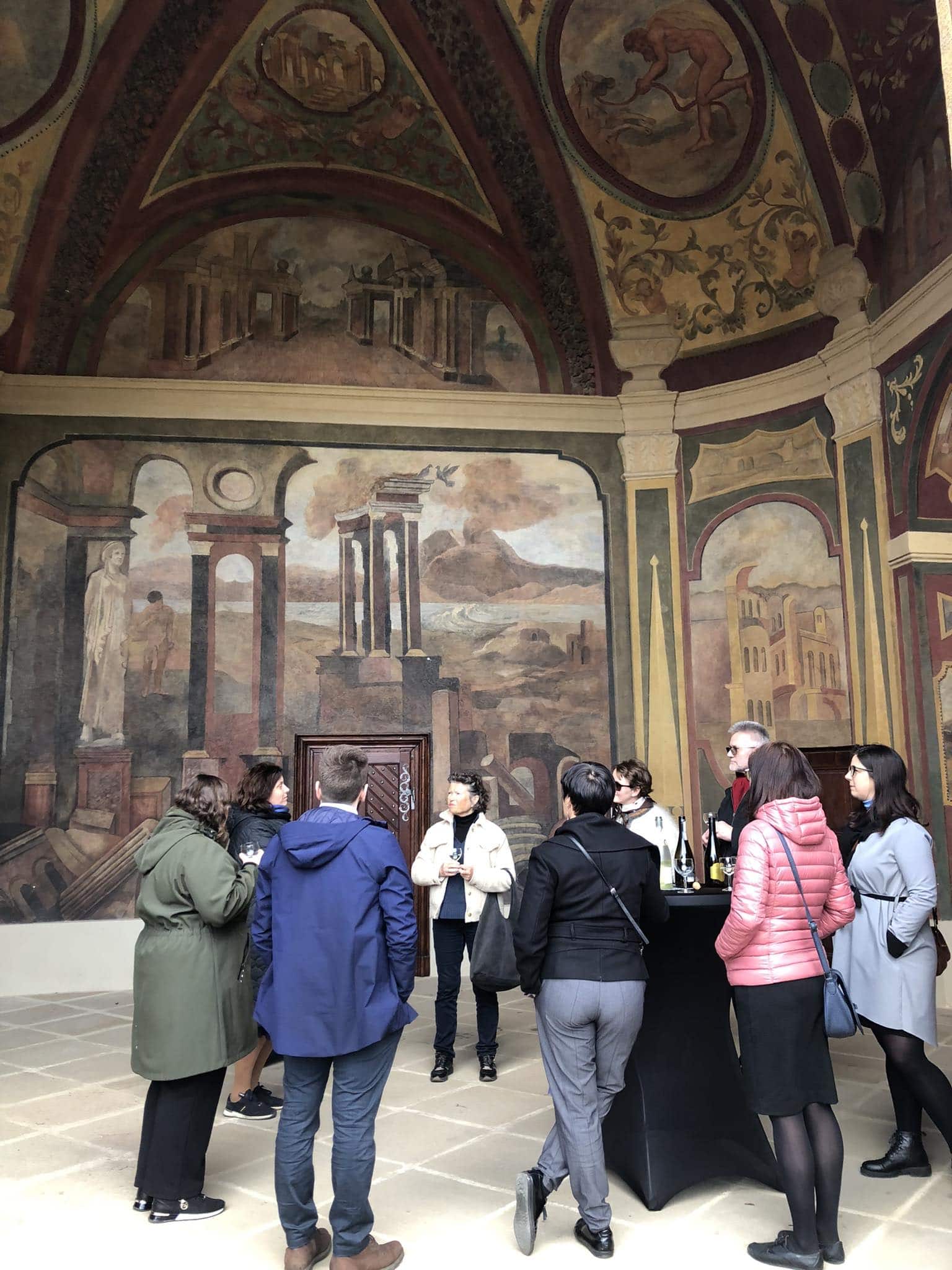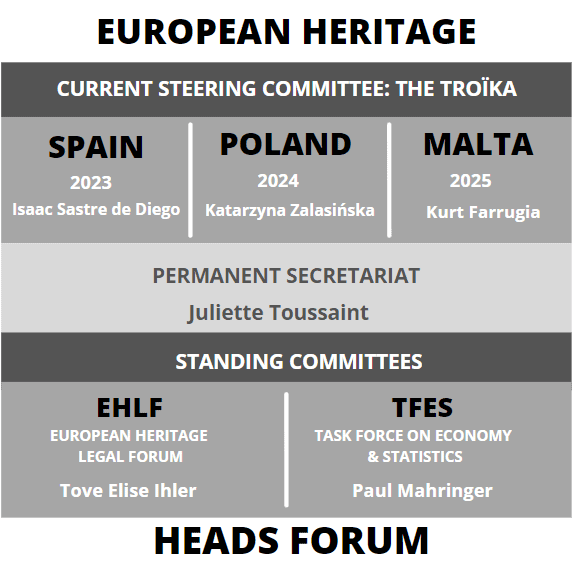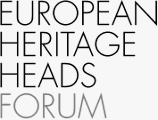“Hosted by the National Heritage Institute of Czech Republic”

The European Heritage Legal Forum (EHLF) met on April 19-20th 2023 in Prague for its annual meeting, which brought together 17 participants from 13 countries. This meeting was an opportunity to take stock of the legislation discussed within the European institutions and which could have an impact on cultural heritage (directive on the energy efficiency of buildings; regulation on the use of lead; etc.). It was also an opportunity to exchange on common issues and to be inspired by the good practices of each other (solar panels on heritage buildings, insurance adapted to heritage, shortage of craftsmen specialised in the renovation and restoration of heritage,…).
Papers
MEMO EPBD 2023
Strengthening cultural heritage resilience for climate change
Minutes EHLF Assembly 2023
Exchange of good practices
Icomos European quality guidelines: experiences / recommandations / examples of practice ?
Denmark
Do not use them.
Slovenia
European quality princpiles are translated in Slovene; not directly included in polices, however the document is a reference and a tool for conservators.
Flanders
The recommandations are not part of the law. The ICOMOS Quality guidelines are mostly seen as guidlines taken into consideration when devellopping calls for European Funding Programs (Horizon, Interreg, …) on EU and national level.
Existence of a system of compensation for the owners who are not allowed to install solar panels on their property?
Denmark
No, it does not exist.
Slovenia
No compensation so far; a proposal for 30 % increase of subsidies in compensation to 30 % less efficient red panels, has not been adopted, yet.
Flanders
No such compensations exist.
Cooperation between institutions responsible for heritage and the ones responsible for the protection of environment?
Denmark
Yes. For example: Agency for Culture and Palaces/Ministry of Culture of Denmark cooperates with Nature Agency/Danish Coastal Authority/Minestry of Enviroment of Denmark.
Slovenia
Very good cooperation: Ministry of Culture- Institute for the protection of CH-Ministry for the Environment and Energy-Ministry for Infrastructure.
Flanders
Flanders Heritage agency is part of the Environmental Department . There is cooperation between institutions for heritage and the ones for the protection of the environment but mostly on a case-based level. There is no such thing as a combined environmental/heritage protection.In some cases the policys can’t be ‘combined’. In the heritage field there is f.ex. some fear that the nature restoration law will have a big impact on the cultural landscapes (forestation, newly created wetlands, …)
How can owners have access to information about solar panels?
Is there a special system to inform them?
Austria
The energy efficiency standards for listed buildings (Austrian Federal Monuments Authority, 2021 = https://www.bda.gv.at/service/publikationen/standards-leitfaeden-anleitungen/standards-energieeffizienz.html) were supplemented by information sheet no. 3 “Photovoltaics and monument protection” (Austrian Federal Monuments Authority, 2023). Available on the website of the Austrian Federal Monuments Authority, https://www.bda.gv.at/service/buergerservice.html. The Federal Energy Efficiency Act was promulgated with Federal Law Gazette I No. 59/2023 on June 14, 2023 and its main parts come into force on the day following the promulgation. https://www.ris.bka.gv.at/eli/bgbl/I/2023/59
short facts:
In section 4, when filling in the survey documents for recording the energy use for statistical purposes in § 47 Para. 4 Z 2 lit d), “information on monument protection” is specified.
In § 49 Para. 2 Z 3 buildings there is an exception with regard to the fulfillment of the minimum energy requirements when renting or purchasing objects by the federal government if these are for the purpose of preservation as a building, which is part of a designated environment or due to its special architectural or historical value is officially protected.
In Section 50, paragraph 5, the following are exempt from the energy saving obligation (according to paragraphs 2 and 3):
1. Buildings officially protected as part of a designated environment or for their special architectural or historical value, to the extent that meeting certain minimum energy performance requirements involves an unacceptable change in their character or appearance;
2. Buildings owned by the federal government and used for national defense purposes, with the exception of individual quarters or office buildings for the army and other national defense officials;
3. Buildings used for worship or other religious purposes, and
4. Federal buildings, with a total floor area of 250 m² or less.
Denmark
No herritage, alment ja
Slovenia
No special system. Just Google and the information from producers.
Flanders
Information ad guidelines are available on the website of the agency.
https://heritagetribune.eu/belgium/monuments-and-sustainability-flanders-allows-solar-panels-on-nearly-all-monuments/ https://www.onroerenderfgoed.be/zonnepanelen
https://www.onroerenderfgoed.be/publicaties/afwegingskader-zonne-energie-een-erfgoedcontext
https://oar.onroerenderfgoed.be/publicaties/AKOE/5/AKOE005-001.pdf
Is your country involved in the European year of Skills ?
Austria
No, they are not.
Ressources on the search for and training of craftmen https://www.bda.gv.at/themen/kartause-mauerbach/kartause-mauerbach-info.html
https://www.bda.gv.at/themen/kartause-mauerbach/european-heritage-academy.html
Denmark
Denmark is participating in the European Year of Skills 2023 with several initiatives. For example the representative organization Danske Regioner will utilize 20% of the EU Socialfond Plus for STEM educations, the green transition and the education of skilled workers. This is an expansion on programs that already exist in Denmark, with the intent to further strengthen these in alignment with the goals of the European Year of Skills 2023.
Slovenia
No.
Flanders
Flanders Heritage is not involved in the European Year of Skills The national representaive is based in the department of Work and Social Economy.
Best practices from your countries with regard to passporting of art/artefacts into and the freely exiting the country ?
Denmark
In certain situations, the National Museum delivers objects to the country of origin, e.g. Greenland.
Flanders
Topstukkendecreet (Masterpiece decree) – Department of Culture https://www.vlaanderen.be/cjm/nl/cultuur/cultureel-erfgoed/regelgeving/topstukkendecreet The Masterpiece Decree sets out a number of important outlines:
Authorization for bringing masterpieces outside Flanders: To bring masterpieces outside the Flemish Community, you need an authorization. This authorization requirement applies both to movable property and collections that have been included in the List of Masterpieces, and to movable property and collections that have not been included in this list but do meet the ‘rare and indispensable’ criteria of the Masterpiece Decree.
Authorisation for the permanent removal of Masterpieces from Flanders
Authorisation for the temporary transfer of Masterpieces outside Flanders
Bringing heritage objects outside the European Union: Both masterpieces and non-masterpieces remain subject to the European Council Regulation no. 116/2009 of December 18, 2008 on the export of cultural goods. If the movable property or collection falls under one of the fifteen specified categories, an EU export license is always required.
Certificate of non-protection as a masterpiece: As the owner or authorised representative of a cultural good or collection you can apply to the Flemish Government for a certificate of non-protection as a masterpiece. This certificate serves as an official confirmation that the movable good or collection to which this certificate relates is not a masterpiece within the meaning of the Masterpiece Decree. A certificate of non-protection as a masterpiece remains valid for 10 years from the date of issue.
List of masterpieces: this list contains all recognized rare and indispensable cultural objects subject to special protection measures regarding physical intervention and bringing them out of Flanders. Owners, possessors or holders of a masterpiece on the List of Masterpieces can apply for a restoration subsidy for any physical intervention on this protected object. These subsidies can amount to a maximum of 80% of the cost of conservation and restoration. The Council for the Conservation of Movable Cultural Heritage (the Top Items Council) advises the Minister on the application of the Top Items Decree. and Immovable Heritage Decree (Flanders Heritage) for archaeological objects art. 5,2,3 The owner or user of an archaeological artifact or of an archaeological ensemble originating from the Flemish Region shall report his/her intention to do so to the agency at least thirty days before taking it outside the Flemish Region. The Flemish Government may determine the detailed rules for this.
The owner or user of an archaeological artifact or an archaeological ensemble shall be exempted from reporting his/her intention to remove it from the Flemish Region, as referred to in the first paragraph, if the removal from the Flemish Region lasts no more than five years and is for educational, scientific, or conservation purposes and if a written agreement is concluded to that effect. The written agreement may be renewed several times for a period not exceeding five years. Renewal of the agreement also does not require notification.
Do owners in your country have difficulties with ensuring enlisted buildings? In that case, how do you approach this problem? Existence of insurance companies specialised in heritage items?
Denmark
Yes. Most ensuring companies will not offer insurances for listed building protected under the Danish Act No. 219 of 6 March 2018 on Listed Buildings and Preservation of Buildings and Urban Environments. Only one or two companies in Denmark offer insurance at a very high cost compared to not-listet buildings. These companies are not specialized in listed buildings they just offer to insure the buildings. It is almost impossible for owners to get an insurance for change of ownership. And it I challenging for owners of buildings because when a house is damaged and parts need to be replaced, the insurance only replaces common materials and often not with the types of materials that are stipulated in relation to Danish legislation.
Flanders
We do not have indications of this problem existing in Flanders.
Do your country have economic incentive to support owners of enlisted and/or historic buildings? i.e tax/vat measures or other means?
Austria
No.
Denmark
Yes.
1. Owners of listed buildings can get a grant/subsidy for construction work that supports, strengthens or restores the building’s conservation values (their special architectural or historical merit).
2. Owners can get exemption from paying land tax (“grundskyldsfritagelse”), if the owner of the listed building chooses to register a conservation declaration on their property (an agreement between the owner and the state, in which the owner waives the right to claim state takeover of the property if a later application for demolition of the listed building is rejected).
3. The owners of listed buildings can deduct the actually incurred operating expenses for the building from their taxable income. The actual operating expenses include, among other things expenses for the building’s maintenance, insurance, road, sewer and water connection tax, renovation and chimney sweeping. Consumption-dependent expenses for water, electricity, heating etc. are not eligible for deduction. Alternatively, the owners of listed buildings can choose to use the so-called “decay per year deduction” for renovation costs. The deduction applies to both maintenance and improvement costs of the listed building. An owner cannot use the right of deduction if the person owns an owner-occupied flat in a listed building and lives in the flat himself. The “decay per per year deduction”- scheme is based calculations that the organization “Bygningsfredningsforeningen BYFO” makes. The listed building is measured, and an expected lifespan is determined for each individual building part. From this, BYFO calculates the annual expenditure for renovation per part of the building and calculates the total decay per year amount. BYFO is also responsible for reporting the deduction to the tax authorities.
Flanders
https://www.onroerenderfgoed.be/ik-wil-financiele-ondersteuning-krijgen (subsidies ) There are subsidies, loans and personal income taks reductions for works on protected buildings (restoration and maintenance) and a sales and gift taks reduction https://www.onroerenderfgoed.be/vermindering-personenbelasting (personal tax reduction) https://www.onroerenderfgoed.be/verlaging-verkooprecht-en-schenkbelasting (sales and gift)
Due to the size of the Pdfs, some files had to be compressed to be displayed on the website.
Original versions with higher resolutions are available upon request to the EHHF Secretariat: secretariat@ehhf.yellowpimento.com.
A little bit of history
A European Heritage Summit was first organized in London on 26–28 April 2006 by Dr. Simon Thurley, former Chief Executive Officer of English Heritage. The mission of the Summit was to gather for the first time the European cultural heritage leaders who had the opportunity to exchange their experience and initiate common actions. It was attended by 23 European states which agreed in the Final Statement to continue to meet annually as a forum of European heritage heads, known as the “European Heritage Heads Forum”. Future hosting countries are chosen by general agreement at the annual meeting.


Permanent Secretariat - secretariat@ehhf.eu - Place Saint-Géry 23, 1000 Brussels
Cookie policy - Privacy policy - Copyright © European Heritage Heads Forum, All rights reserved.
Permanent Secretariat - secretariat@ehhf.eu
Place Saint-Géry 23, 1000 Brussels
Cookie policy - Privacy policy
Copyright © European Heritage Heads Forum
All rights reserved.
